Here we are providing Class 12 Biology Important Extra Questions and Answers Chapter 14 Ecosystem. Important Questions for Class 12 Biology are the best resource for students which helps in Class 12 board exams.
Class 12 Biology Chapter 14 Important Extra Questions Ecosystem
Ecosystem Important Extra Questions Very Short Answer Type
Question 1.
What is an ecosystem?
Answer:
Ecosystem. It is a functional unit of nature where living organisms interact among themselves and also with the physical environment.
Question 2.
Who coined the term ecosystem?
Answer:
Sir Arthur Tansley (1935).
Question 3.
Name two major kinds of ecosystems.
Answer:
- Terrestrial ecosystem.
- Aquatic ecosystem.
Question 4.
Write three examples of terrestrial ecosystems.
Answer:
Forests, grasslands, and deserts ecosystem.
Question 5.
Give one example of the smallest and another of large-sized ecosystems.
Answer:
- Pond
- Forest.
Question 6.
Give three examples of freshwater ecosystems.
Answer:
Ponds, Lakes, and Streams ecosystems.
Question 7.
Name two saltwater ecosystems.
Answer:
Marine and estuaries ecosystems.
Question 8.
Name two man-made ecosystems.
Answer:
- Spacecrafts
- Aquarium
- Crop field.
Question 9.
Write two examples where man has interfered in the ecosystem.
Answer:
- Cutting of forests
- Construction of dams.
Question 10.
How do decomposers obtain food?
Answer:
Decomposers release their enzymes into dead and decaying plants and animal remains and absorb the simple inorganic substances.
Question 11.
Give two examples where there is the transfer of matter from terrestrial to the aquatic ecosystem or vice-versa.
Answer:
- Dropping of leaves of riverbank trees into the water.
- Terrestrial birds diving into the water to catch fish.
Question 12.
Write the equation that helps in deriving the net primary productivity of an ecosystem. (CBSE Delhi 2013)
Or
How will you calculate net productivity?
Answer:
GPP – R = NPP
Gross primary productivity – Respiratory processes (loss) = Net primary productivity
Or
Net primary productivity = Gross productivity – respiration loss.
Question 13.
Why are green plants not found beyond certain depths in the ocean? (CBSE 2011)
Answer:
The sunlight cannot penetrate beyond certain depths in the ocean.
Question 14.
Why are green algae not likely to be found in the deepest strata of the ocean? (CBSE Outside Delhi 2013)
Answer:
Green algae are not likely to be found in the deepest strata of the sea because the environment is perpetually dark and the sun as a source of energy is not available.
Question 15.
Name two aquatic ecosystems which have a rich diversity of macrophytes.
Answer:
Wetlands and lakes.
Question 16.
Name two structural features of the ecosystem.
Answer:
- Species composition
- Stratification.
Question 17.
How does the standing state of nutrients differ?
Answer:
The standing state of nutrients differs from one ecosystem to another or with the season in the same ecosystem.
Question 18.
Define detritus.
Answer:
Dead plant and animal remains are called detritus.
Question 19.
Name above ground and below ground detritus.
Answer:
- Dried plant parts and dead animals.
- Dead roots (root detritus).
Question 20.
What is nutrient immobilization?
Answer:
Soil nutrient gets tied up with biomass of microbes and is not available for other organisms.
Ecosystem Important Extra Questions Very Short Answer Type
Question 1.
List the abiotic components of an ecosystem.
Answer:
The abiotic components of an ecosystem are of four types:
- Inorganic substances like C, N2, O2, C02, H20, etc.;
- Organic compounds like carbohydrates, proteins lipids, etc.;
- Climatic factors (including temperature, light, wind, gases, humidity, rain, and water) (also wave action, water currents),
- the edaphic factor which includes soil.
Question 2.
List the differences between biotic and abiotic components of the ecosystem.
Answer:
Differences between Biotic and Abiotic Components of the ecosystem:
| Biotic components | Abiotic components |
| 1. Biotic components of an ecosystem are those Living organisms that are different members of a community. | 1. Abiotic components are non-living factors. |
| 2. Biotic components of an ecosystem are: (i) Producers (ii) Consumers (iii) Decomposers. |
2. It includes water, minerals, salts, humidity, light, temperature, pH, wind, topography, and background. |
Question 3.
List the kinds of ecosystems.
Answer:
An ecosystem can be as small as an aquarium in the house or as big as an ocean. The biotic community is spread everywhere. Land, water, and air show the presence of living things.
The major ecosystems of the world are:
| Aquatic ecosystem | Terrestrial ecosystem | Man-made ecosystem |
| [A] Marine (i) Oceans (ii) Seashore (iii) Brackish[B] Fresh Water (i) Lakes and rivers (ii) Spring and ponds (iii) Swamp |
[A] Forest (i) TropicaL (ii) Temperate (iii) Taiga[B] Grassland (i) Tropical (ii) Temperate[C] Desert [D] Tundra |
(i) Aquarium (ii) Crop fields (iii) Spaceship (iv) Garden and parks (v) Small fishery tanks (vi) Animal husbandry (vii) Dams and reservoirs |
Question 4.
Show the processes involved in the decomposition of detritus.
Or
Describe the process of decomposition of detritus under the following heads: Fragmentation, Leaching, Catabolism, Humification, and Mineralisation. (CBSE 2010)
Answer:
Process of decomposition:
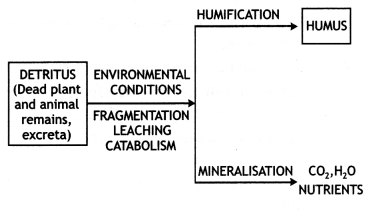 Processes involved in the decomposition of detritus
Processes involved in the decomposition of detritus
- Fragmentation: Detrivores break down detritus in small particles.
- Leaching: Water-soluble inorganic nutrients seep inside the soil and get precipitated as unavailable salt.
- Catabolism: Here, bacteria and fungus degrade detritus by their enzymes into simple inorganic ions.
- Humification: Formation of hummus at a slow rate.
- Mineralization: Release of minerals from humus by microbes.
Question 5.
What are the functions of the ecosystem?
Answer:
Functions of the ecosystem. Ecosystems possess a natural tendency to persist. This is made possible by a variety of functions (activities undertaken to ensure persistence) performed by the structural components.
The key functions of the ecosystem are:
- Productivity;
- Energy flow;
- Nutrient cycling;
- Decomposition
Question 6.
What is a food chain? List the kinds of food chains.
Answer:
Food Chain: A nutritive interaction among biotic communities (organisms) involving a producer, various levels of consumers, and a decomposer forms a food chain. Each step in a food chain is called a trophic level. Kinds of the food chain. There are 3 kinds of food chains: predator, parasitic and saprophytic chains.
Question 7.
In relation to energy transfer in the ecosystem, explain the statement “10 kg of deer’s meat is equivalent to 1 kg of lion’s flesh”.
Answer:
Passage of food energy from lower trophic level to higher trophic level follows 10% law. 10% law states that only 10% of total energy is transmitted from one trophic level to another. The rest of the energy is dissipated. A lion feeds on deer (lower trophic level). So 10 kg of meat of deer will form only 1 kg of lion’s flesh. The rest of the food energy present in deer meat is wasted and dissipated.
Question 8.
Primary productivity varies from ecosystem to ecosystem. Explain.
Answer:
Primary productivity depends upon the producers (plant species), their photosynthetic potential, soil, climate, and other environmental factors of an ecosystem. They are seldom similar in different ecosystems. Therefore, primary productivity varies from ecosystem to ecosystem.
Question 9.
What is an incomplete ecosystem? Explain with the help of a suitable example.
Answer:
An ecosystem comprises biotic and abiotic components. Abiotic components include light, air, water, temperature, humidity, etc., while biotic factor comprises all living organisms. The absence or limited availability of any component (either abiotic or biotic) makes an ecosystem incomplete like the profundal and benthic zones in an aquatic ecosystem.
Question 10.
What are the shortcomings of ecological pyramids in the study of ecosystems?
Answer:
Ecological pyramids are the graphical representation of ecological parameters. These are characterized by a pyramid of the number, the pyramid of mass, and the pyramid of energy in an ecosystem. The assumption of a simple food chain is the major shortcoming of ecological pyramids.
If we do not provide a food web, a clear position of the trophic levels of an organism cannot be given. Saprophytic organisms are not given any place in the ecological pyramid, though they are an important component in an ecosystem.
Question 11.
Write a note on secondary productivity.
Answer:
Secondary productivity. It refers to synthesized biomass at different trophic levels beginning from primary consumer level to top-level carnivores. At each consumer level, a part of the energy is used for respiration and a part of it is stored. If there is more storage than consumption, the biomass of the population would be higher at the end of a time period than at the beginning. This rate of increase in biomass of heterotrophs is called secondary productivity.
Question 12.
Sketch Pyramid of energy. Why is pyramid energy upright? (CBSE Delhi 2019 C)
Answer:
A pyramid of energy is always upright: It is a graphic representation of energy, amount of energy trapped per unit time, and area in different trophic levels of a food chain with producers forming the base and top consumer at the top.
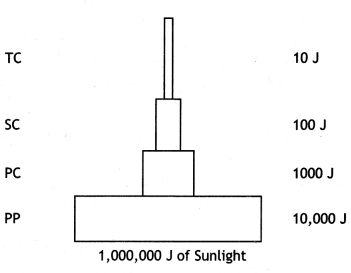
An ideal pyramid of energy. Observe that primary producers convert only 1% of the energy from the sunlight available to them into NPP.
There is the unidirectional flow of energy in a food chain. As the energy passes from one trophic level to a higher trophic level along the food chain, its amount decreases. So, the pyramid of energy is always upright.
Question 13.
Construct a pyramid of biomass starting with phytoplankton. Label its three trophic levels. Is the pyramid upright or inverted? Justify your answer. (CBSE Sample Paper 2020)
Answer:
A pyramid of biomass is an aquatic ecosys¬tem and is always inverted. The biomass of primary producer (PP) phytoplankton is smaller than the biomass of zooplankton. The latter constitute primary consumers (PC). The biomass of carnivores, i.e. fish, a secondary consumer (SC), is more than the biomass of the primary consumer. So the pyramid of the biomass of the aquatic ecosystem is inverted.
 Pyramid of biomass
Pyramid of biomass
Question 14.
What is eco-succession? Write its kinds and pattern.
Answer:
A continuous change in a biotic community is called biotic or eco-succession. A stage of climax is also achieved in the process of succession. Succession is of two types primary and secondary. The pattern of succession in any community is decided by pre-existing conditions of that place.
Three kinds of patterns have been observed:
- Xerosere,
- Hydrosere and
- Merosere.
Question 15.
What are the causes of ecological succession?
Answer:
- Biotic and physiographic factors operating simultaneously are the causes of ecological succession.
- Biotic factors, direct succession, and physiographic factors include the climate and other physical factors such as erosion of hills, filling up of lakes and streams.
Question 16.
Give a generalized mode of ecosystem nutrient cycling.
Answer:
A generalized model of ecosystem nutrient cycling:
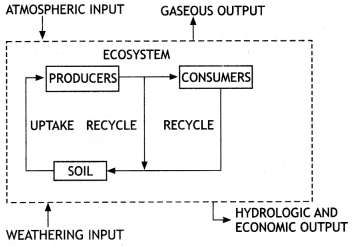
A generalized model of ecosystem nutrient cycling: Nutrients are brought in (input), moved out (output), and cycled internally in the ecosystem. Boxes represent ecosystem components and arrows show the pathways of nutrient transfers.
Question 17.
Where would you look for signs of secondary succession? When does secondary succession end?
Answer:
Secondary succession occurs where an early community has been damaged leaving a few organisms and considerable organic matter. A destroyed grassland, destroyed forest, or destroyed area by fire or floods will be the site for secondary succession. The development of climax forests marks the end of secondary succession. A destroyed grassland takes 50 to 100 years to recuperate and a destroyed forest takes 200 years to fully recover.
Question 18.
Name the pioneer and the climax species in a waterbody. Mention the changes observed in the biomass and biodiversity of the successive serai communities developing in the waterbody. (CBSE 2009)
Answer:
- Pioneer communities are the small phytoplankton, which is replaced with time by rooted-submerged plants, rooted-floating angiosperms followed by free-floating plants, then reed swamp, marsh-meadow, scrub, and finally the trees.
- The climax again is forest.
Ecosystem Important Extra Questions Long Answer Type
Question 1.
What is an ecosystem? Write its main components.
Answer:
Ecosystem. A stable, self-supporting ecological unit resulting from an interaction between a biotic community (living organisms) and its abiotic environment is called an ecosystem.
An ecosystem comprises two main components:
- biotic including plants, animals, and microorganisms and
- abiotic mainly including substratum, water, minerals, temperature, carbon dioxide, and oxygen. It must also receive a constant supply of energy (light).
Question 2.
Briefly describe the biotic components of an ecosystem.
Answer:
Biotic components: Of an ecosystem’s biotic components, the plants are producers as they introduce food materials and energy into the living world. The animals are consumers because they get food and energy by consuming plants directly thus called primary consumers (herbivores); secondary/ tertiary consumers (carnivores) obtain energy and food indirectly from plants, and microorganisms are decomposers for they flourish by breaking dead organic matter to simple substances that are returned to environment for reuse by plants.
In an ecosystem, nutrients are used again and again in a cyclic manner, whereas energy trapped from sunlight is lost as heat.
Question 3.
Give an account of factors affecting the rate of decomposition.
Answer:
Factors affecting decomposition:
- The upper layer of soil is the main site of decomposition processes in the ecosystem.
- The rate of decomposition of detritus is affected by climatic factors and the chemical quality of detritus.
- Temperature and soil moisture affect the activities of root microbes.
- The chemical quality of detritus is determined by the relative proportion of water-soluble substances, polyphenols, lignin, and nitrogen.
Question 4.
List the important differences between producers and decomposers.
Answer:
Differences between producers and decomposers:
| Producers | Decomposers |
| (i) These are organisms that synthesize their own food by the process of photosynthesis. These are also called autotrophs. | (i) These organisms feed on the dead bodies of plants and animals. |
| (ii) They convert the raw materials in the earth and water into carbohydrates which give them food. | (ii) They enrich the earth with raw materials trapped in dead bodies of plants and animals. |
| (iii) They are dependent on decomposers for soil nutrients. | (iii) They are dependent on plants and animals for their food. |
Question 5.
Explain the terms standing crop, biomass, and standing state.
Or
State what does a standing crop of a trophic level represent? (CBSE Outside Delhi 2013)
Answer:
Standing crop: Each trophic level has a certain mass of living material at a particular time called the standing crop. Biomass. The standing crop is measured as the mass of living organisms (biomass) or the number in a unit area. The biomass of a species is expressed in terms of fresh or dry weight. Measurement of biomass in terms of dry weight is more accurate as the moisture content of biomass fluctuates greatly.
Standing State: Organisms need a constant supply of nutrients to grow, reproduce and regulate various body functions. The amount of nutrients, such as carbon, nitrogen, phosphorus, calcium, etc. present in the soil at any given time, is referred to as the standing state. It varies in different kinds of ecosystems and also on a seasonal basis.
Question 6.
Give a diagrammatic representation of trophic levels in an ecosystem.
Answer:
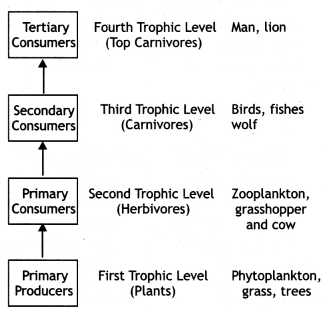
Diagrammatic representation of trophic levels in an ecosystem.
Question 7.
Sometimes due to biotic/abiotic factors, the climax remains in a particular serai stage (pre-climax) without reaching climax. Do you agree with this statement? If yes give a suitable example.
Answer:
Sometimes pre-climax stage remains in a particular serai stage without reaching the climax because during ecological succession any change in abiotic and biotic components may affect the particular serai stage, leading to the pre-climax stage before the climax is achieved.
This type of condition occurs in the presence of seeds and other propagules. This secondarily based area may be invaded by moss or exotic weeds thus exhibiting succession seriously and the climax community is never regenerated.
Question 8.
Explain the meaning of the food web and illustrate with a ray diagram.
Answer:
Food web. In nature, the food chains are not strictly linear, but are interrelated and interconnected with one another. Generally, the various food chains in a community are so interlinked as to form a sort of web. As a result, one animal may be a link in more than one food chain.
A network of food chains in a community is referred to as a food web. A food web may have all or some of the three types of food chains, i.e. detritus, predator, and parasitic. The food webs become more complicated because of the variability of taste and preference, availability and compulsion, and several other factors at each level. For example, tigers normally do not eat fish or crab, but they are forced to feed on them in the Sundarbans.
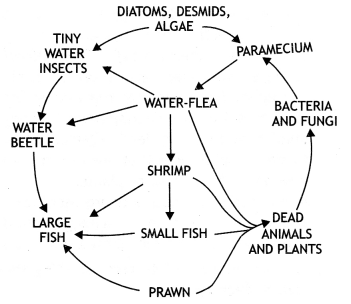
Question 9.
Starting from a bare rock or a site of volcanic eruption, trace the organisms that participate in the process of succession. (CBSE Delhi 2011)
Or
Describe the process of succession on a base rock. (CBSE 2012)
Answer:
- Simple organisms appear first of all on such an exposed site as lichens. Lichens make conditions suitable for mosses (bryophytes).
- Gradually a variety of complex organisms join the community.

Stages of biotic succession. - Finally, large plants, trees, etc. appeared. It can be illustrated that lichens are pioneers, followed by mosses, annual grasses, perennial herbs, shrubs, and finally trees along with their characteristic animal populations.
Question 10.
How does succession differ in terrestrial and aquatic systems? Give salient points. (CBSE Delhi 2019)
Answer:
Differences between terrestrial and aquatic succession:
| Succession on land/rock | Succession In Water |
| 1. lichens and mosses are the pioneer community. | 1. Phytoplankton is a pioneer community. |
| 2. Soil is formed by the action of lichens. | 2. Waterbodies are prone to silting due to soil erosion. |
| 3. There is a deficiency of water. | 3. Water is abundant. |
| 4. The various stages are crustose lichen stage, foliose lichen stage, moss stage, herb stage, shrub stage, and forest stage. | 4. The various stages are the plankton stage, floating stage, rooted stage, swamp stage, woodland stage, and forest stage. |
Question 11.
Explain the difference between the serai stage and climax community during succession.
Answer:
Change during succession:
| Characteristics | Seral | Climax |
| Community structure: Size of individuals Ecological niches |
Small Few, generalized |
large Many specialized |
| Community organization: | Simple | Complex |
| Community functions: Food chains and food Efficiency of energy use Nutrient conservation |
Simple low low |
Complex High High |
Question 12.
(a) Write the pioneer species each of xerarch and Hydr-arch successions. Which type of climax community is attained by both these successions?
Answer:
- Pioneer species of xerarch succession: Wind-borne lichen propagules settle on wet rock soon after rain or heavy dew. Pioneer lichens are crustose lichens. Examples: Graphis, Rhizocarpon.
- Climax stages of xerarch succession: Trees growing in areas occupied by shrubs.
- Pioneer species of Hydr-arch succession: Phytoplankton examples are diatoms, green flagellates, single-celled or filamentous green algae as well as blue-green algae.
- Climax stages of hydra succession: Climax forest of trees
(b) Why is secondary succession faster than primary succession? Explain. (CBSE 2019 C)
Answer:
Secondary succession is faster than primary succession:
- It has a secondarily based area built-in soil organic matter.
- It is biologically fertile.
- Underground parts, some seeds, and remnant species quickly give rise to a new community.
Secondary succession takes 50-100 years to complete in grassland and 100—200 years for the development of the forest. It takes short time as com¬pared to primary succession.
Question 13.
Outline the salient features of the ecosystem nitrogen cycling.
Answer:
Salient features of the ecosystem nitrogen cycle are listed below.
- The ultimate source of nitrogen is an atmosphere that cannot be directly metabolized by living organisms.
- Nitrogen-fixing bacterial activities facilitate the entry of nitrogen into biological pathways.
- Azotobacter and Clostridium are the major free nitrogen-fixing bacteria in the soil.
- Ammonification is done by many bacteria.
- Ammonia is converted into nitrate by a group of chemoautotrophic bacteria through a two-step process called nitrification.
- Denitrifying bacteria transform nitrate nitrogen to nitrous and nitric oxides ultimately to gaseous nitrogen.
- Most plants absorb nitrate from soil.
Question 14.
List the features of the phosphorus cycle.
Answer:
Features of the phosphorus cycle are listed below.
- The natural reservoir of phosphorus is a rock in the form of phosphates.
- Minute quantities of phosphates get dissolved in the soil solution during weathering of rocks.
- Phosphates enter the plants through their roots and then the food chain.
- The organic wastes and dead organisms are decomposed by phosphate-solubilizing bacteria, which release phosphorus back into the soil.
- The atmospheric input of phosphorus through rainfall or gaseous exchange of phosphorus between organisms and the environment is negligible.
Question 15.
“In a food-chain, a trophic level represents a functional level, not a species. Explain.” (CBSE Delhi 2016)
Answer:
In a food chain, a trophic level represents a functional level:
- Trophic level is a step or division of the food chain. It is characterized by the method of obtaining food.
- The number of trophic levels is equal to the number of steps in the food chain.
- The two fundamental trophic levels are producers and consumers.
- Producers are autotrophic organisms found in the ecosystem which synthesize food from raw materials. There are many such organisms at this level that comprise the first trophic level and not just one species, e.g. green algae plant, phytoplankton, etc.
- Consumers are heterotrophic organisms. Herbivores are primary consumers. In a pond ecosystem many crustaceans, larvae of insects constitute this trophic level.
Similarly, at the next trophic level, a number of small fishes, not just one species consist of the secondary consumer.
Question 16.
Explain the impact of human activities on the carbon cycle in nature and list its harmful effects. (CBSE Delhi 2019 C)
Answer:
Impact of human activities on the carbon cycle: Carbon is a component of all living organic compounds of protoplasm. It constitutes 49% of dry weight. C02 is present in the air. It is dissolved in water as carbonic acid and bicarbonates. It is also present in fossil fuels and graphite in rocks.
There is a regulation of the carbon cycle in nature. Rapid deforestation and the massive burning of fossil fuel for energy and transport have significantly increased the rate of releasing C02 into the atmosphere. Harmful effect. Greenhouse effect and global warming.
Question 17.
What are ecosystem services? Briefly explain. (CBSE Delhi 2019)
Answer:
Ecosystem Services. The products of ecosystem processes are named ecosystem services.
Examples:
The following services are provided by the forest ecosystem.
They are:
- purify air,
- mitigate droughts and floods,
- help in the cycling of nutrients,
- provide habitat to a number of the wildlife,
- act as a storehouse of carbon,
- influence the hydrological cycle and
- maintain biodiversity.
The value of services of biodiversity is difficult to determine. Robert Constanza et al. have tried to put price tags on nature’s life-support services. Researchers have estimated them to be 33 trillion US dollars a year, while our global gross production is only 18 trillion US dollars.
Question 18.
What are the two main components of an ecosystem? Describe the physical factors which affect the distribution of organisms in different habitats.
Answer:
Abiotic (physical) and biotic components are the two main components of an ecosystem.
Abiotic components or physical factors:
1. Temperature: The physiological and behavioral adaptations of most animals depend upon the changes in the environmental temperature. The rates of photosynthesis and respiration in plants also fluctuate depending upon the change in temperature.
2. Water: The extent to which an organism is dependent on an abundant water supply depends on its requirements and its ability to conserve it in adverse conditions. Organisms living in dry habitats generally have good water conservation such as in cacti and camels.
3. Light: This is essential for all green plants and photosynthetic bacteria, and for all the animals dependent on the plants.
4. Humidity: This is important because it can affect the rate at which water evaporates from the surface of an organism, which in turn influences its ability to withstand drought.
5. Wind and air currents: This particularly applies to plants. Only plants with strong root systems and tough stems can live in exposed places where winds are fierce. The wind is also instrumental in the dispersal of spores and seeds.
6. pH: This influences the distribution of plants in soil and fresh-water ponds. Some plants thrive in acidic conditions others in neutral or alkaline conditions. Most are highly sensitive to changes in pH.
7. Soil nutrients: These particularly affect the distribution of plants in the soil.
8. Water currents: Particularly in rivers and streams. Only organisms capable of swimming or avoiding strong currents can survive.
9. Topography. Minor topographical differences may be just as important in influencing the distribution of organisms as wide geographical separation.
10. Background. The distribution of organisms whose shape or coloration is such that they are camouflaged when viewed against a particular background is related to the general texture and pattern of the environment.
Question 19.
Name the two fundamental trophic levels and describe the general makeup of each.
Answer:
The two fundamental trophic levels include the following:
1. Producers (Autotrophic organisms): Green plants are the producers in any ecosystem. They also include photosynthetic bacteria. The producers use radiant energy of the Sun during photosynthesis whereby carbon dioxide is assimilated and the light energy is covered into chemical energy.
This energy is locked up into the energy-rich carbon compounds i.e. carbohydrates. The oxygen that is evolved as a by-product in photosynthesis is used in respiration by all living organisms.
2. Consumers (Heterotrophic organisms): They are the living members of the ecosystem which consume the food synthesized by the producers. All living animals are thought to be consumers.
The consumers may be of the following types:
(a) Primary consumers (also called first-order consumers) which are purely herbivorous and depend upon green plants i.e. on producers for their food e.g., Cow, Goat, Rabbit, Deer, Grasshopper, and other insects.
(b) Secondary consumers (also called second-order consumers) are carnivorous animals and eat the flesh of herbivorous animals e.g., Tiger, Lion, Dog, Cat, Frog, etc.
(c) Tertiary consumers are the carnivorous animals that eat other carnivores e.g. Snake eats a frog, birds eat fishes
(d) Top consumers are carnivores of an ecosystem that are not killed and eaten by other animals e.g. Lions, vultures, etc.
Question 20.
Explain the meaning of biotic succession taking an example of succession in a hydrosere.
Answer:
Biotic Succession: The organisms interact among themselves. They not only influence their community but also change their physical or abiotic environment. The alteration in the physical environment is such as to continually favor another set of organisms till a stable community is formed.
Such a biologically controlled modification in the composition of a community of a particular area is called biotic succession or ecological succession. Biotic succession is also known as a successive development of different communities in a particular area till a climax community is formed.
The following seven stages of the hydrosere pattern of succession can be observed:
- Phytoplanktonic stage (Free-floating angiosperm)
- Rooted submerged stage
- Rooted floating stage
- Amphibian or Reed Swamp stage
- Sedge meadow stage
- Woodland stage
- Forest stage.
Question 21.
Give the graphic representation of the nitrogen cycle.
Answer:
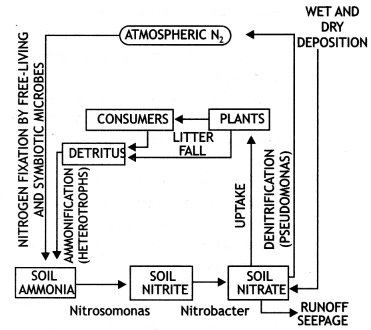
Nitrogen Cycle in Nature.
Question 22.
Distinguish between the following:
(i) Grazing food chain and detritus food chain (CBSE 2008)
Answer:
Differences between grazing food chain and detritus food chain:
| grazing food chain | detritus food chain |
| 1. Primary source of energy is solar radiation. | 1. It is detritus. |
| 2. First trophic level is formed of all producers (plants). | 2. Detritus Food Chain (DFC) begins with detritus or dead organic matter. Detrivores or decomposers feed over it. |
| 3. long-sized food chains. | 3. Small-sized food chains. |
| 4. Examples: Predatory food chains on land and in water. | 4. Examples: Fallen leaves of mangroves in the brackish zone of South Florida. |
(ii) Production and decomposition
Answer:
Differences between production and decomposition:
| Production | Decomposition |
| 1. It is the process of formation of organic food material by the process of photosynthesis. | 1. It is the process by which complex organic compounds are broken into simpler inorganic substances. |
| 2. It is done by green plants (producers). | 2. It is done by bacteria and fungi (decomposers). |
(iii) Upright and inverted pyramid
Answer:
Differences between Upright pyramid and Inverted pyramid:
| Upright Pyramid | Inverted Pyramid |
| In a terrestrial habitat, the pyramid of biomass is maximum at the level of producers and there is a progressive decrease in biomass from lower to higher trophic levels. | In aquatic habitats, the pyramid of biomass is inverted or spindle-shaped whereas the biomass of a trophic level depends upon the reproductive potential and longevity of the members because the biomass of phytoplankton is less than that of zooplanktons. |
(iv) Food chain and food web
Answer:
Differences between food chain and food web:
| food chain | food web |
| 1. A single energy path where energy is transferred from producer to successive order of consumers. | 1. It is the network of various food chains which are interconnected with each other like an interlocking pattern. |
| 2. All food chain starts from plants that are the original source of food. | 2. It has many linkages and intercrossing among the producers and consumers. |
(v) Litter and detritus
Answer:
Difference between Litter and detritus:
| Litter | Detritus |
| 1. It refers to discarded paper and plastics. | 1. Dead plant remains like leaves, bark, flowers, and remains of dead animals including fecal matter is catted detritus. |
| 2. It cannot be decomposed. | 2. It can be decomposed. |
(vi) Primary and secondary productivity.
Answer:
Differences between primary productivity and secondary productivity:
| primary productivity | secondary productivity |
| The amount of biomass or organic matter produced per unit area over a time period by plants during photosynthesis is catted primary productivity. | The rate of formation of new organic matter by consumers is called secondary productivity. |
Question 23.
Define ecological pyramid and describe pyramids of number and biomass.
Or
Construct a pyramid of biomass starting with phytoplankton. Label three trophic levels. Is the pyramid upright or inverted? Why? (CBSE 2009)
Answer:
Definition: An ecological pyramid is a graphical/mathematical representation of an ecological parameter, like a number or biomass or accumulated energy at different trophic levels in a food chain in an ecosystem.
1. Pyramid of number: The pyramid is the graphical/mathematical representation of a number of organisms present at each trophic level in a food chain of a particular ecosystem.
When the number of organisms at successive levels are calculated mathematically and plotted, they assume the shape of a pyramid. This is called a pyramid of numbers. The base represents the number of producers whereas the tip is represented by top consumers; inverted pyramids can also be formed.
In the given pyramid of the number, the number of producers (here grass and trees are the producers) will be far more than any other level. The number of consumers will be comparatively less than herbivores. You can guess if the number of carnivores increases and exceeds the herbivores then what the result will be?
The figure shows an inverted pyramid and there you can see producer is one tree and dependents like primary and secondary consumers are many. Parasite insects of birds will be definitely more than the number of birds.
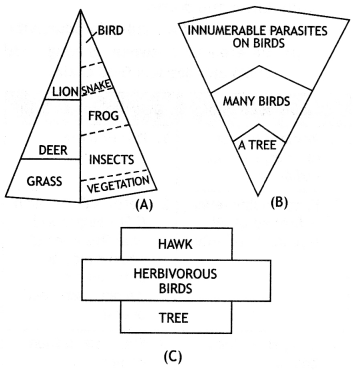
Pyramid of Numbers:
A. Straight—Forest and Water ecosystem
B. Inverted—Tree Ecosystem.
C. SpindLe shaped
2. Pyramid of Biomass: Biomass is defined as the total weight of dry matter present in an ecosystem at a given time. Graphical measurement of biomass is called the pyramid of biomass. Trophic levels at the base represent biomass as numbers in a pyramid of numbers. Here also you can obtain an upright and inverted pyramid.
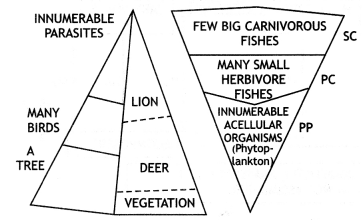
Pyramid of biomass Upright-Tree and forest ecosys¬tem. Inverted-Aquatic ecosystem.
The aquatic pyramid of biomass is always inverted because the biomass of fishes far exceeds the biomass of phytoplankton.
Question 24.
What is primary productivity? Give a brief description of factors that affect primary productivity. (CBSE Delhi 2011)
Answer:
The amount of biomass or organic matter produced per unit area over a time period by plants during photosynthesis is called primary productivity.
It is expressed in terms of gm-2yr-1 or kcal m-2yr-1. Primary productivity depends upon a number of environmental factors like:
- Availability of nutrients which varies in different types of ecosystem.
- Photosynthetic capacity of plants.
- The plant species inhabiting a particular area.
- Environmental factors.
Question 25.
Define decomposition and describe the processes and products of decomposition.
Answer:
Decomposition is defined as the process by which complex organic compounds are broken down into simpler inorganic substances that can be reutilized by plants for their growth.
Decomposition involves the following processes:
| Decomposition process | End products |
| 1. Fragmentation of detritus by the detritivorous invertebrates. | 1. Increases the surface area of detritus for the action of microbes. |
| 2. lead, Ingor Eluviation. | 2. Carrying away soluble nutrients from the A-horizon of soil by downward-moving gravitational water. |
| 3. CatabolIsm involves the breakdown of detritus in the presence of extracellular enzymes released by the decomposers. | 3. Simple organic compounds and Inorganic substances are formed. |
| 4. Humlfication involves the transformation of simplified detritus into fully decomposed, dark-colored, and amorphous humus. | 4. Humus acts as a reservoir of nutrients. |
| 5. Minerailsatlon | 5. Release of inorganic substances like CO2, water, etc., and minerals like K+, Mg++, Ca++, NH+4, etc. In the soil by the action of microbes. |
Question 26.
Give an account of energy flow in an ecosystem.
Answer:
Different components for a universal model of energy flow are shown below: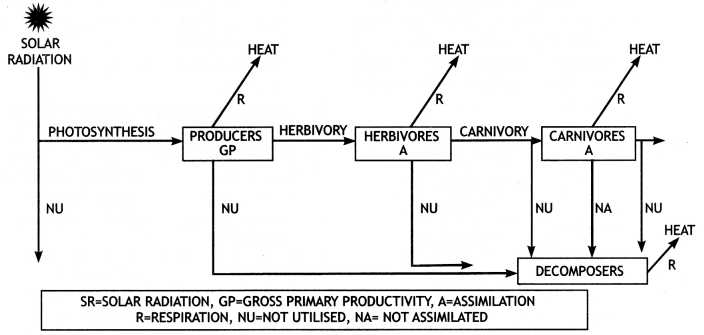
A generated energy flow model of ecosystem-Boxes represent biotic components and the arrows show the pathways of energy transfer
When a herbivore eats a plant, then it digests and oxidizes the ingested food to liberate energy which is equal to that used in synthesizing the organic biomass by the plant. Some of the released energy is lost as heat while only a part of the energy is used in building the biomass of the herbivore, which is called gross secondary productivity.
The same is repeated when the herbivore is eaten by a primary carnivore and so on. At each transfer, about 80-90% of potential energy is dissipated as heat while only 10-20% of energy is available to the next trophic level.
Thus, there is a decline in the amount of energy passing from one trophic level to the next trophic level. The study of energy transfer is called bioenergetics. Secondary productivity tends to be about 10 percent at the herbivore level, although efficiency may be higher, 20 percent at the carnivore level.
So regarding the energy flow, an ecosystem is characterized by the following:
- Unidirectional flow of energy.
- The decrease in useful energy.
- Return of radiant energy of the Sun to the non-living system as heat.
Question 27.
Outline salient features of carbon cycling in an ecosystem. (CBSE Delhi 2012)
Answer:
The reservoirs of carbon are listed below:
- Carbon dioxide present in the air.
- Carbon dioxide dissolved in water.
- Carbonates in the earth’s crust.
- Fossil fuels like coal and petroleum,
- Bicarbonates in oceans.
The carbon cycle is the simplest of all nutrient cycles. Its salient features are listed below:
1. CO2 utilization: Carbon dioxide is used by green plants for the process of photosynthesis, and oxygen is released as a by-product. The fixed carbon enters the food chain and is passed to herbivores, carnivores, and decomposers. About 4 x 1013 kg of carbon is fixed in the biosphere through photosynthesis annually.
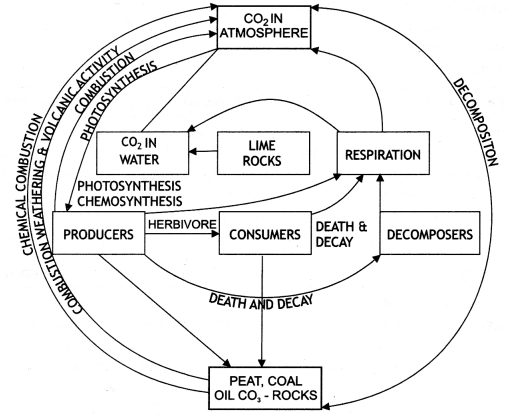
Carbon cycle in nature.
2. C02 production and return to the atmosphere:
(a) Carbon dioxide is released into the atmosphere by the respiration of producers and consumers.
(b) It is also released by the decomposition of organic wastes and dead bodies by decomposers by the action of bacteria and fungi of decay.
(c) Burning of wood and fossil fuels also releases C02 into the atmosphere.
(d) Volcanic eruptions and hot springs also release C02 into the atmosphere.
(e) Weathering of carbonate-containing rocks by the action of acids also adds C02 to the atmosphere.
Question 28.
Name the pioneer species on a bare rock. How do they help in establishing the next type of vegetation? Mention the type of climax community that will ultimately get established. (CBSE 2009)
Answer:
- Lichens and mosses are the pioneer community. Lichens secrete acids which dissolve the rocks and helps in weathering rocks to form soil.
- Soil is formed by the action of lichens.
- Invasion is the successful establishment of species.
- The reaction is most important in succession. It is the mechanism of modification of the environment due to the influence of living organisms. Changes take place; annual grasses, perennial herbs, shrubs, and finally trees appear along with animal communities.
- Angiosperms trees forming forests will form climax communities.
Question 29.
(i) What is an ecological pyramid? Compare the pyramids of energy, biomass, and numbers.
Answer:
Ecological pyramid: An ecological pyramid is a graphical representation of an ecological parameter, like a number or biomass or accumulated energy at different trophic levels in a food chain in an ecosystem.
Ecological pyramids are of three types:
- Pyramid of number
- Pyramid of biomass
- Pyramid of energy
| Pyramid of energy | Pyramid of biomass | Pyramid of number |
| (i) The relationship between producers and consumers in an ecosystem represented in the form of a pyramid in terms of the flow of energy is called the pyramid of energy. | (i) The relationship between producers and consumers in an ecosystem represented in the form of a pyramid in terms of biomass is called the pyramid of biomass. | (i) The relationship between producers and consumers in an ecosystem represented in the form of a pyramid in terms of number is called the pyramid of number. |
| (ii) It is always upright. | (ii) It can be upright or inverted. | (ii) It can be upright or inverted. |
(ii) Write any two limitations of ecological pyramids. (CBSE 2017)
Answer:
Limitations of ecological pyramids:
(a) Ecological pyramid never takes into account the same species belonging to two or more trophic levels.
(b) It assumes a simple food chain, which never exists in nature.